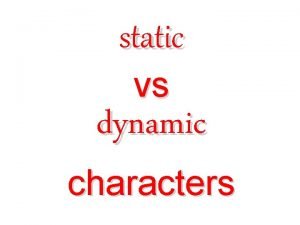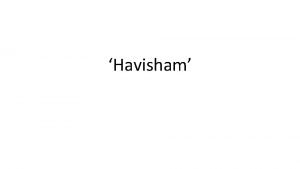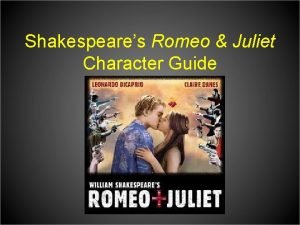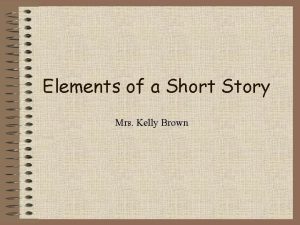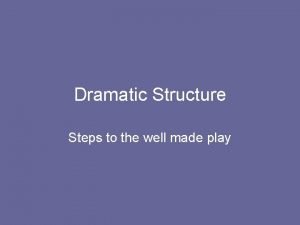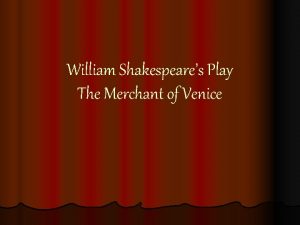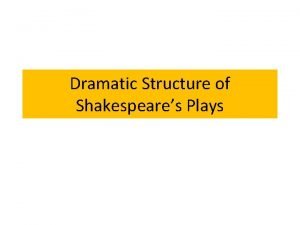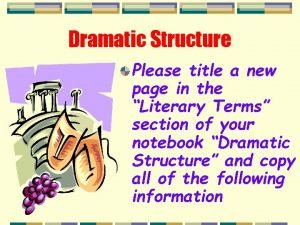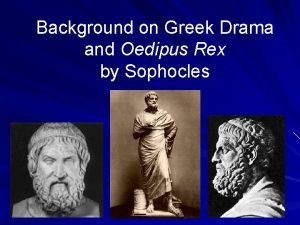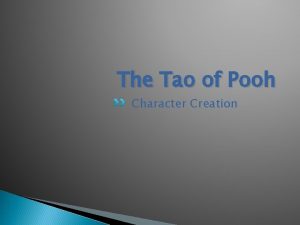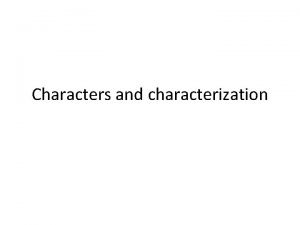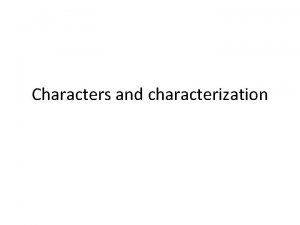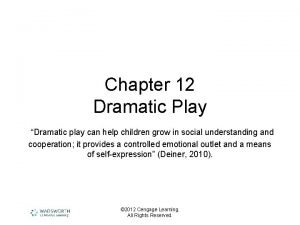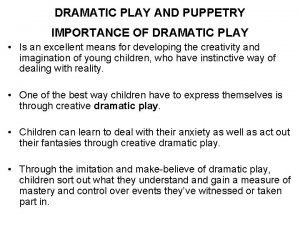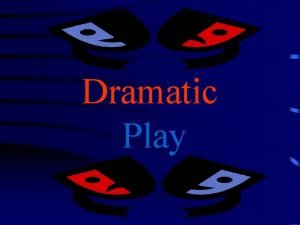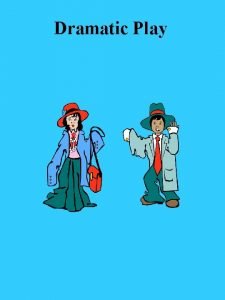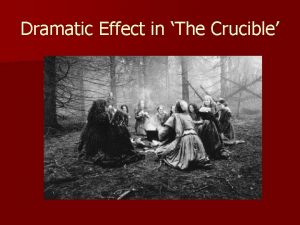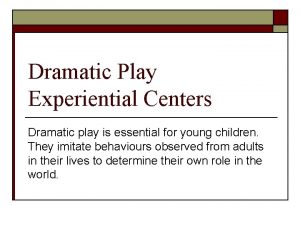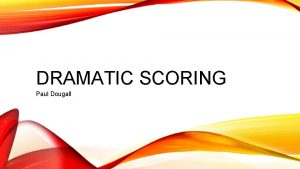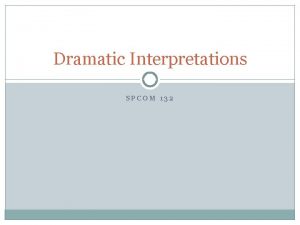DRAMATIC STRUCTURE AND DRAMATIC CHARACTERS Chapter 7 Characteristics

















- Slides: 17

DRAMATIC STRUCTURE AND DRAMATIC CHARACTERS Chapter 7

Characteristics of Dramatic Structure Dramatic Forms • • • Climactic Episodic Combination of Climactic and Episodic Disconnected Episodes Based on Ritualistic Pattern Musical Theatre Structure

Climactic Structure The Plot Begins Late in the Story • Exposition - Must first establish the background or setting • • of the play. It is information necessary for an understanding of the story but not covered by the action onstage; events or knowledge from the past, or occurring outside the play, which must be introduced so that the audience can understand the characters or plot. Running Action - All the roads of the past move toward a central crucial intersection in the present. Climax – The crucial convergence of crossroads. The highpoint in the development of a dramatic plot.

Climactic Structure The Plot Begins Late in the Story • Falling Action – After the climax, the road to a resolution that is a consequence of the climax. • Denouement –The final resolution to the plot. • Cliff hanger – Climax at the end of the plot that leaves the audience “hanging”. • Scenes, Locales and Characters Are Limited • Started out much like Greek theatre and moved to five acts, then three acts and down to two acts. • Today, long one-act plays with no intermission are frequently presented.

Climactic Structure The Plot Begins Late in the Story • Construction Is Tight • Cause and Effect Relationship • Well-made plays – Type of play popular in the 19 th century and • early 20 th century that combines apparent plausibility of incident and surface realism with a tightly constructed, highly causal, and contrived plot. Deus ex machina – Literally, “god from a machine”, a resolution device in classic Greek drama, hence, intervention of supernatural forces—usually at the last moment—to save the action from its logical conclusion. In modern drama, an arbitrary and coincidental solution or in melodrama, a “hero comes to save the day”.

Episodic Structure The Plot Begins Early in the Story • • • Less Cause and Effect Relationships Plot or action usually begins early in the play The forces are centrifugal, moving out to embrace additional elements • Shakespearian plays are excellent examples of episodic structure • People, Places and Events Proliferate • Covers an extensive period of time • Long scenes alternate with shorter ones • Use of many characters

Episodic Structure The Plot Begins Early in the Story • There may be a parallel plot or subplot • A secondary plot that reinforces or runs parallel to the major plot in an episodic play. • Scenes can move back and forth through time (not necessarily cause and effect). • Scenes can move from place to place.

Episodic Structure The Plot Begins Early in the Story • Scenes can alternate from one group of characters to another group. • Many current movies/TV shows use parallel or subplots such as “Game of Thrones” and many others • Juxtaposition and contrast occur • Comic scenes can alternate with serious scenes • The overall effect is cumulative

Climactic • • Plot begins late Covers short space of time Contains a few long scenes in generally three acts Restricted locale Limited number of characters (6 -8) Plot is linear with few, if any, subplots or counterplots Line of action proceeds in a cause-andeffect chain The characters and events are closely linked in a sequential, logical and almost inevitable development Episodic • • Plot begins early Covers long space of time Contains many short scenes or combination of short and long scenes Ranges over many places Many characters (several dozen) Several threads of action such as tw parallel plots or comic relief inside a serious play Scenes are juxtaposed to one another

• Combination of Climactic and Episodic Form • Rituals as Dramatic Structure • Rituals are generally ceremonial events, often religious, which take place in a prescribed sequence. • Avant-garde theatre often uses this form of structure • Patterns as dramatic structure as in “Waiting for Godot” • Serial Structure as in a “musical revue”

Structure in Experimental and Avant-Garde Theatre • Special Structures • Emphasis on nonverbal theatre • Gestures, body movements and sounds tell the story • Reliance on improvisation or a scenario developed by performers and the director to tell the story, rather than a written text • Interest in ritual and ceremony • Stress on the importance of the physical environment of theatre, including the spatial relationship of the performers to the audience

Structure in Experimental and Avant-Garde Theatre • Segments and Tableaux as Structure • A Tableau (tableaux-plural) in theatre is a static scene onstage featuring performers in costume depicting a scene that tells a story. Using the idea of frames in a movie film, the director uses these live 3 -dimensional picture frames to tell a story moving from one frame to the next, almost like the silent pictures did with rapid jerky moves.

Structure in Musical Theatre • Alternation and Juxtaposition • Musical numbers alternate with spoken scenes • Solos and duets alternate with choral numbers • Singing alternates with dance numbers • Sometimes comic songs and scenes alternate with serious ones

Dramatic Characters • Extraordinary Characters • Historical Characters of Early Theatre – Kings and Queens, larger than life or “unique” as opposed to “ordinary” people • Comic Characters – Can also be extreme

Dramatic Characters • Representative or Quintessential Characters Ordinary characters that embody or represent an entire group of people • Stock Characters Two dimensional, stereotypical characters • Commedia dell’arte – Form of comic theatre originating in Italy in the 16 th century in which dialogue was improvised around a scenario involving a set of stock characters, each with a traditional costume, name and often mask

Dramatic Characters • Characters with a Dominant Trait Similar to stock characters but which possessed a singular “dominant trait” • Minor Characters in all types of plays who play a small part in the overall action of the play • Narrator or Chorus An individual or group of individuals who speak or sing “directly to” the audience, sometimes pursuing a dramatic persona • Nonhuman Characters

Dramatic Characters • Juxtaposition of Character Types • Protagonist • Principal character in a play, the one whom the drama is about • Antagonist • Opponent of protagonist in a drama • Orchestration of Characters
 What is a dynamic character
What is a dynamic character Monologues
Monologues Characteristics of romeo and juliet characters
Characteristics of romeo and juliet characters Elements of the story
Elements of the story Dramatic structure of oedipus rex
Dramatic structure of oedipus rex What is the well made play
What is the well made play Climactic plot
Climactic plot Plot of merchant of venice
Plot of merchant of venice Basic plot structure
Basic plot structure Dramatic structure chart
Dramatic structure chart Dramatic effect essay
Dramatic effect essay Dramatic structure of antigone
Dramatic structure of antigone Dramatic structure of oedipus rex
Dramatic structure of oedipus rex The dao of pooh
The dao of pooh What are mannerism characteristics
What are mannerism characteristics Dramatic irony in the bet
Dramatic irony in the bet Surface structure and deep structure
Surface structure and deep structure Deep surface structure
Deep surface structure
